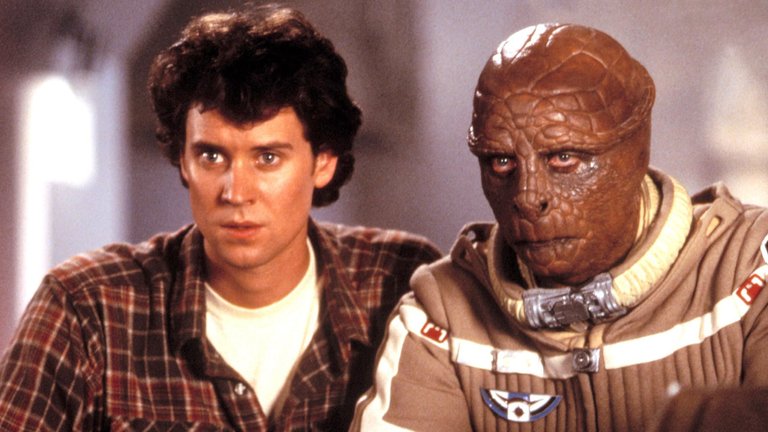Film Review: The Last Starfighter (1984)

Many films earn important pages in cinema history simply for being first to feature certain important technical innovation. It never hurts to be good films at the same time, but it doesn’t happen that often. One of such rare examples is The Last Starfighter, 1984 science fiction film directed by Nick Castle, best known as the first film with visual effects almost completely made with the help of CGI technology.
The plot begins in Californian trailer park where the protagonist, high school student Alex Rogan (played by Lance Guest) dreams of leaving and starting new and better life with his girlfriend Maggie Gordon (played by Catherine Mary Stewart). Alex is frustrated by the apparent failure to leave and tries to fight boredom by constantly playing video arcade game Starfighter in which the player must protect Star League from evil invaders Xur and Ko-Dan. Alex is very good at the game and after he breaks the game record, gets approached by Centauri (played by Robert Preston), mysterious individual who claims to be the inventor of the game and offers Alex a prize. Alex agrees to sit in Centauri’s car and soon finds that the car is actually a space ship, that Centauri is an alien and that the Star League, Xur and Ko-Dan are real. It turns out that Starfighter is not just a video game, but actually tool used by Star League to recruit and train best pilots from the different planets. Alex is offered to become real space pilot, but he is initially overwhelmed and wants to go home. There he starts having second thoughts and reconsiders his decision after realising that Xur and Ko-Dan might endanger Earth and his loved ones.
Made only two years after Tron, first major Hollywood film featuring computer animation, this film shows how quickly technology can advance. Unlike that film, which used computers to create world very much like the primitive video games of the era, The Last Starfighter actually featured photorealistic visual effects made with the help of Cray X-MP supercomputer. This not only allowed impressive display of space combat, but also allowed to film to be made with lower budget and on schedule, paving the way for many future productions that would embrace that technology. All that would be of little value if not for the very good script by Jonathan R. Beutel. The plot is based on the ingenious idea of using the game as a tool to produce real life results, somewhat similar to the concept Orscon Scott Card would use in his novel Ender’s Game. But even more important is successful synthesis of the story and character elements from the best films of Lucas and Spielberg. The film features ordinary and, at first, reluctant hero, while at the same time promoting the values of family, friendship and community. Film spends large part in showing the ordinary world of Alex Rogan, thus making the audience to not only sympathise with him as a hero, but also understand his ultimate decision to protect his loved ones.
Nick Castle directs this film well, handling the complicated CGI scenes with ease and keeping the tight pace which allows The Last Starfighter to be much shorter than today’s blockbusters. He also had good cast at his disposal. Lange Guest is very good as ordinary young hero, but the clever addition of his android double – brought by aliens in order to cover Alex’s absence – allows Guest to show extra acting skills and display good comedic ability. Catherine Mary Stewart is good as his love interest, torn between following Alex’s dreams and fear of leaving the community in which she had spent entire life. Those performances are, however, overshadowed by character actors in side roles. Veteran Robert Preston as lovable alien conman shines in his last feature film role, which was written specifically for him. Dan O’Herlihy also leaves very good impression as Alex’s reptilian navigator Grigg, despite heavy makeup that makes him actually unrecognisable. Craig Safan, composer who worked mostly on television, delivers surprisingly energetic musical score. Not everything is commendable in this film – production design of alien bases is slightly unimaginative, while chief villain, played by Norman Snow, is forgettable and the film at times drowns in cliches. The ending is somewhat annoying at the end while it shows producers’ attempt to leave room for the sequel. Yet, despite those flaws, The Last Starfighter made good money at the box office and created fandom that lasts to this day.
RATING: 7/10 (++)
Blog in Croatian https://draxblog.com
Blog in English https://draxreview.wordpress.com/
Leofinance blog https://leofinance.io/@drax.leo
Cent profile https://beta.cent.co/@drax
Minds profile https://www.minds.com/drax_rp_nc
Uptrennd profile https://www.uptrennd.com/user/MTYzNA
Hiveonboard: https://hiveonboard.com?ref=drax
Rising Star game: https://www.risingstargame.com?referrer=drax
1Inch: https://1inch.exchange/#/r/0x83823d8CCB74F828148258BB4457642124b1328e
BTC donations: 1EWxiMiP6iiG9rger3NuUSd6HByaxQWafG
ETH donations: 0xB305F144323b99e6f8b1d66f5D7DE78B498C32A7

Haha, this movie brings back such fond memories. I remember watching this over and over again and still enjoying it even though I was very familiar with everything that was going to happen.
Now there is a film that brings back childhood memories...classic! !PIZZA
PIZZA Holders sent $PIZZA tips in this post's comments:
@stickupboys(3/20) tipped @drax (x1)
Learn more at https://hive.pizza.
https://twitter.com/draxblog/status/1449091564630945793
The rewards earned on this comment will go directly to the person sharing the post on Twitter as long as they are registered with @poshtoken. Sign up at https://hiveposh.com.